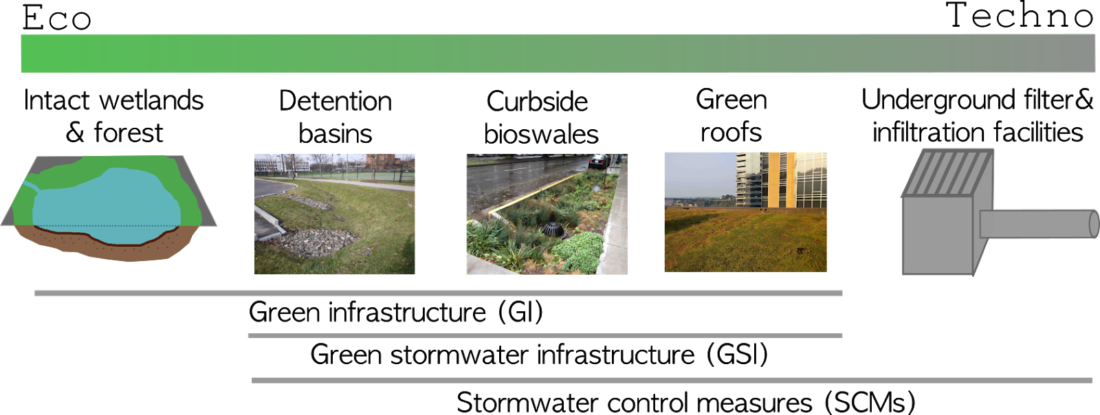Green Infrastructure Research
Green infrastructure has been a unifying theme across all UREx network cities, given its potential for providing stormwater management in conjunction with other co-benefits like heat mitigation or aesthetic improvement. Green infrastructure implementation is in various stages in our network cities, from well-developed programs in Portland to initial stages of implementation in Hermosillo. While some research efforts are focusing on the specifics of design or governance in particular cities, new research generated through the UREx SRN strives to compare various aspects of green infrastructure across multiple network cities.

Green infrastructure can have different connotations for different people or disciplines. The figure above highlights our perception of green infrastructure and related strategies along the ecological-technological spectrum.
Highlighted Projects
Erin Looper, graduate student at Portland State University, coordinated with SRN scientists to have soils sampled during summer 2017 to assess ecological function in stormwater detention basins in Baltimore, New York, Phoenix, Portland, and Syracuse. Erin is interested in the basin soil microbial community’s capacity to process nutrients in stormwater, and is examining how that varies across the cities, and along with design and management characteristics of the basins.
Rae Zimmerman, faculty collaborator from New York University, has led a GI financing project, looking at what influences funding attractiveness and how GI users can design funding to support GI. The approach is to link types of GI financing to GI attributes at the project level for selected sets of GI projects nationwide including some URExSRN cities, and GI databases have been identified and coded. Preliminary findings indicate a high degree of variability in funding types across GI projects with different characteristics, and some sources are opportunistic, traditional or regulatory driven.
Lauren McPhillips and Marissa Matsler, UREx postdoctoral fellows, have been working on an analysis of green stormwater infrastructure (GSI) portfolios in Baltimore, Phoenix, and Portland (chosen because they had the most comprehensive data available on GSI implementation). They looked at how types and amount of GSI varied across the cities, and how that has been implemented over time. Portland has the greatest density of GSI and Baltimore has the greatest diversity of GSI types, while Phoenix has an impressive density of GSI for a desert city. Both Baltimore and Portland have had striking transitions in GSI types over the last few decades, driven by needs to improve water quality.
Cliff Davidson, faculty collaborator from Syracuse University, has been working with a number of students to measure the performance of the green roof on the Onondaga County Convention Center, aka the OnCenter. This green roof is part of the county’s Save-the-Rain program, which now has over 220 green infrastructure projects in and around Syracuse. Save-the-Rain was implemented to mitigate the Combined Sewer Overflow (CSO) and flooding problems caused by runoff from impermeable urban surfaces, similar to the problem in many rust belt cities in the eastern U.S.
In addition to showing how well the roof is performing in its capacity to mitigate the CSO and flooding problems, it was recognized that measurement of stormwater flows and energy flows on the roof could have major educational benefit. In conjunction with the Syracuse University School of Education, a website was set up to show data coming directly from the green roof. The signals from monitoring equipment on the roof are sent back to campus (1.6 km away) by a line-of-sight radio link. The signals are then used to create real-time graphs on the green roof website.
Research at the OnCenter includes monitoring of precipitation and stormwater runoff through the roof drains, and monitoring of soil moisture to examine the roof’s hydrologic performance. The research also includes monitoring of temperatures in different layers of the roof over time to examine heat flow under a range of weather conditions and soil moisture conditions.

